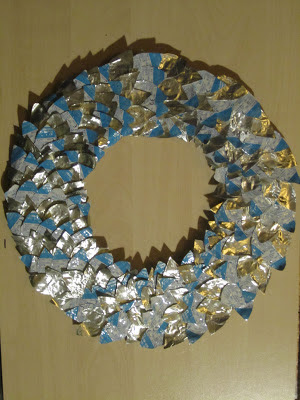For the last ten days, I've been taking part in the Recycle
for London Food Waste Challenge. Last weekend I managed to chalk up over 3
kilos of food waste. I appreciate that
the challenge is not about creating as much waste as possible, but I was very
happy with the total. Here’s why.
The problem with a challenge like this is it tends to be
self-selecting: the people who sign up are probably already very aware of
eating sustainably and rather pleased with the way they manage food and
leftovers economically and creatively.
My blog persona (WasteladyN8) is such a one. So if anything my aspiration
for this fortnight has been to produce a zero result, not just reduce my waste..
But then I went to stay with my elderly mother in
Ireland. My mum is 92 and lives on her
own. She is part of a kindly village
community and is well supported by friends and local services. Every Friday she rings through her food order
to the local Spar who deliver four or five bags of groceries (plastic bags, I’m
afraid, but we will see what happens when the ban comes through in Northern
Ireland). My brother and I come to see
her regularly and then there are usually twice as many bags!
During my visit, one of my jobs is to clean out the fridge
and the vegetable rack: hence the shameful total in this week of Food Waste
Challenge. So what kind of things
featured in the list of shame? Sausages,
pies and dairy products, now out of date; bruised or mouldy fruit and vegetables;
stale bread; and a pie case that had lost its crispness.

Actually although I used the word, ‘shame’ (twice), I don’t
want to be judgemental. For one thing,
some of the items were mine, mostly the fancy ones, such as the pie case and
the apples I was going to make into chutney.
When I asked my mum why she ordered so much, she explained that she
followed the list she always used, because it was easier to do this 'automatically.’ Bending down, checking
the fridge, planning meals ahead is an effort.
Her diet is very simple and healthy but she never actually eats all the
cauliflower, carrots and head of celery she orders every week. I suspect the vegetables are really an
aspiration, one she never quite lives up to, and she is not alone there. It’s a bit like having a gym membership and
never going.
In my mother’s case, buying food is just another chore which
she needs to make as easy as possible, relying on a trusted formula which is
not responsive to different situations.
I have tried putting systems in places, such as lists and inventories,
but in the end, it is up to her. Asking
her helper to put away the groceries and write a list for the coming week might
be the solution, but Mum needs to be involved in the process.
Another factor is the guests. When my brother, wife, son and new wife came
to stay, Mum ordered three of everything, except for the chicken. She ordered two of those. Help! They were so full afterwards, they
could hardly stand.
My mother’s attitude to food is not atypical in Northern
Ireland. Surprising for such thrifty,
down-to-earth people, the helpings in restaurants and hotels are enormous and
the best compliment you can bestow upon a restaurant is, it gives you ‘a good
feed.’ The carvery is the meal of choice,
always difficult for me, because of the compulsion to balance a bit of
everything on one plate, return to the table and then struggle to finish. A local hotel introduced a similar system for
desserts, but that proved uneconomic: a waitress is now employed to stand guard
over the array of sweet temptations.
For me the challenge of food waste is not just to reduce or
reuse it creatively but to explore the psychology behind it. The upside of waste is to see it not as extravagance
and poor management, but abundance, a perception which is deeply embedded in
our culture and indeed psyche. We know
we are hardwired to eat high calorie foods for fear of famine and starvation,
and to feast on surplus.
By the same token, appearing stingy is inhospitable and so
we overcompensate by being overly generous with portions and choice. And just as the provider does not want to appear
stinting, the recipient does not want to seem ungrateful or ungracious. I suppose the solution is to desist, to say a
gentle and firm, ‘No thank you,’ which will establish boundaries and set
precedents, but that is not always easy in social (and family) situations.
Reducing food waste should be fun, a challenge to meet and
cherish, not another opportunity to feel less than perfect. In a world of abundance and opportunity, we all
slip up. As I go into the second week,
I am curious to see what my results will be and I'm hoping to finally get round
to making that chutney!




































